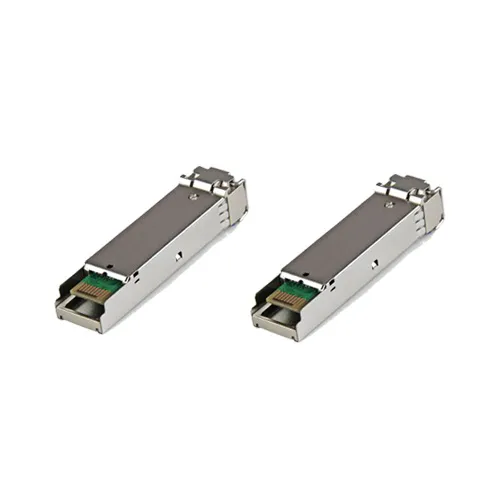Optical modules :Introduce its structure, classification, and application
Brief introduction
Optical modules are composed of optoelectronic devices, functional circuits, and optical interfaces. Optoelectronic devices include two parts: transmitter and receiver.
Simply put, the function of an optical module is to convert electrical signals into optical signals at the transmitting end, transmit them through optical fibers, and then convert the optical signals into electrical signals at the receiving end.
Optical modules are optoelectronic devices that perform photoelectric and electro-optical conversion. The transmitting end of the optical module converts electrical signals into optical signals, while the receiving end converts optical signals into electrical signals. Optical modules are classified according to their packaging forms, commonly including SFP, SFP+, SFF, GBIC, etc.
Structure
The transmission part is to input a certain bit rate electrical signal, which is processed by an internal driving chip to drive a semiconductor laser (LD) or light-emitting diode (LED) to emit a modulated optical signal at a corresponding rate. The internal part is equipped with an optical power automatic control circuit to keep the output optical signal power stable.
The receiving part is: the optical signal with a certain bit rate is input into the module and converted into an electrical signal by the photodetector diode. After passing through the preamplifier, the corresponding bit rate electrical signal is output.
Classification
Classified by function
Including optical receiving module, optical transmitting module, optical transceiver integrated module, and optical forwarding module.
The main function of the optical transceiver integrated module is to achieve photoelectric/electro-optic conversion, including optical power control, modulation transmission, signal detection, IV conversion, and limited amplitude amplification decision regeneration functions. In addition, it also has anti-counterfeiting information query, TX-disable and other functions. Common ones include SFP, SFF, SFP+, GBIC, XFP, 1x9, etc.
In addition to the photoelectric conversion function, the optical forwarding module also integrates many signal processing functions, such as MUX/DEMUX, CDR, functional control, energy acquisition and monitoring. Common optical forwarding modules include: 200/300pin, XENPAK, and X2/XPAK.
Optical transceiver module, also known as optical module or fiber module, is an important component in fiber optic communication systems.
Divided by parameters
Plugability: hot swappable and non hot swappable
Packaging forms: SFP, GBIC, XFP, Xenpak, X2, 1X9, SFF, 200/3000pin, XPAK.
Transmission rate: The transmission rate refers to the number of bits transmitted per second, measured in Mb/s or Gb/s. The optical module products cover the following main speeds: low-speed,100 megabytes,1000 megabytes,2.5G, 4.25G, 4.9G, 6G, 8G, 10G, and 40G.
Divided by packaging
1.XFP(10 Gigabit Small Form Factor Pluggable)is a hot swappable, communication protocol independent optical transceiver used for 10G bps Ethernet, SONET/SDH, and fiber channel.
2.Small pluggable light receiving and emitting modules (SFP) are currently the most widely used.
3.The GigacBiDi series single fiber bidirectional optical module utilizes WDM technology to transmit bidirectional information signals through a single fiber (point-to-point transmission. Especially when fiber resources are insufficient, one fiber is needed to transmit bidirectional signals). GigacBiDi includes SFP single fiber bidirectional (BiDi), GBIC single fiber bidirectional (BiDi), SFP+single fiber bidirectional (BiDi), XFP single fiber bidirectional (BiDi), SFF single fiber bidirectional (BiDi), and so on.
4.RJ45 electrical port small pluggable module, also known as electrical module or electrical port module.
5.SFF is further divided into 2x5, 2x10, etc. based on its pins.
6.Gigabit Ethernet Interface Converter (GBIC) module.
7.Passive optical network PON (A-PON, G-PON, GE-PON) optical module.
8.40Gbs high-speed optical module.
9.SDH transmission module (OC3, OC12, OC48).
10.Storage modules, such as 4G, 8G, etc
To find products and services more accurately, please try entering keywords for search.
For more product and service content, please contact us and send an email to sales@dimud.com.
We sincerely look forward to connecting with you!


